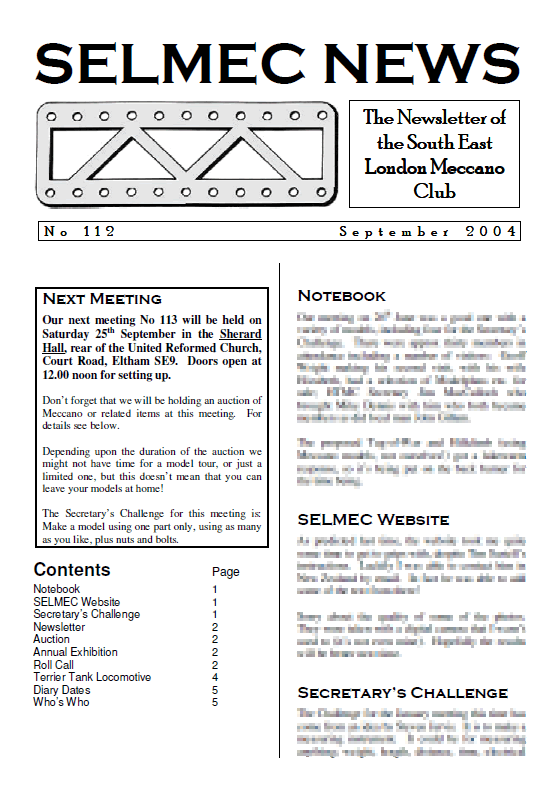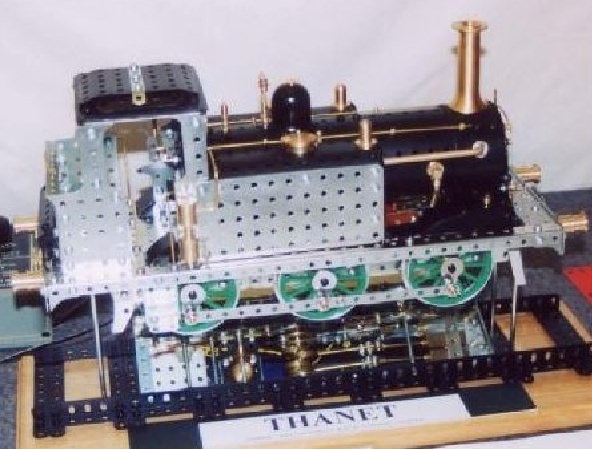September 2004 Newsletter

September 2004 Newsletter
Issue 112
This was one of our informal quarterly meetings where our members showed off their latest Meccano creations.
At around 2:00pm we had a short committee meeting, followed by the Model Tour in which members were invited to give a short talk about their models — in particular their entries for the Secretary’s Challenge!
Written by Mike Dennis
General Information and History
Between 1872 and 1880, fifty class A1 ‘Terrier’ locomotives were designed by William Stroudley and built at the Brighton works for the London Brighton & South Coast Railway specifically for London and other suburban passenger duties. They could be seen regularly hauling up to twelve four-wheel coaches each 26ft long and were christened ‘Terriers’ by the crews. They were later rebuilt as Class A1X and for their diminutive size they were powerful, reliable and economical on coal, which made them very popular to operate.
They carried the names of various London boroughs and towns in Surrey and Sussex and such is their fame, reliability and popularity, that 20% of those made are preserved in working order and used in films and TV plays etc on a regular basis.
Nine are resident in the UK performing with various steam preservation groups, including the Bressingham Steam museum, the Bluebell, and Kent & East Sussex Railways and another ‘Waddon’ can be seen in the Canadian National Railway Museum.
Some Meccano was used
The locomotive model is based on the Terrier, as originally built. The name I gave to the model is fictitious. It is surrounded by a ring of Hornby HO gauge track on which runs a typical branch line three-coach train of four-wheel S. R. Olive Green four-wheelers, plus a 20 Ton ex L. B. S. C. R. four-wheel Brake van finished in Brown, with Hornby Isle of Wight № 13 ‘Carrisbrooke’ issued in June 2004, finished in Southern Green, hauling it at a realistic speed. The main exhibit is mounted on up stands above an angled mirror to allow viewers to observe the motion work whilst in motion. The boiler, tanks, tool box, smokebox front plate and splashers are made with all Meccano parts and at least 14 unadulterated Meccano parts were used in the chassis (not counting all the nuts and bolts and even ‘holey’ washers)!! The splashers were cut, bent and soldered (leaded) from hinged plates (made useful at last) and the cab contains most scale details including Gauges, a shovel – opening fire door and a sliding bunker flap revealing real coal! The only thing missing from the cab floor is a scale fag end but I am working on it as it might be made from pure Meccano but outside atop the bunker real coal can be seen again!

The Thanet locomotive
The cab sides, spectacle plates and tank ends are cut from zinc plated flat plates made and supplied by David Fellows. Many special parts were made to suit such as handrails, chimney, dome, safety valves, and all other brass fittings. Most of the non-Meccano parts use a Meccano part too – (even if it is only a nut or bolt) so I do not feel any sense of guilt as the great man said I can use them etcetera!!
The wheels are of the ‘Slater’ type as used on ‘00’ ‘0’ & 1 gauge model railway locos. Those on this loco are made to my own design and feature turned aluminium rims, laser cut 12 spoked acrylic centres from 3 mm sheet and Meccano size bosses which are part threaded for the eccentric securing bolts and clearance for the Meccano axles.
The eccentrics are fishplates and 38D washers with Meccano threaded pins as the crank pins. (More Meccano — WOW). The wheels are correctly ‘quartered’ and the valve timing is ‘compensated’ by placing the eccentrics slightly out of true position to impart partial movement to the valve rods from the Stevenson reversing links which are normally curved for working reversing lever mechanisms but as reverse is simulated only I used 3 hole narrow strips. The buffers and chassis are both sprung and the crankshaft, connecting rods, cylinders, eccentrics and all the valve gear are fabricated using a mixture of Meccano parts and standard Mecarep micro rod system parts. The locomotive is powered by a Faulhaber 12V motor and will also run on a track via the pickups which can be seen on the front four wheels.
Footnote
Patterns, drawings and other details can be supplied. The model was described stage-by-stage as it was being built on the Half Inch Systems Group.